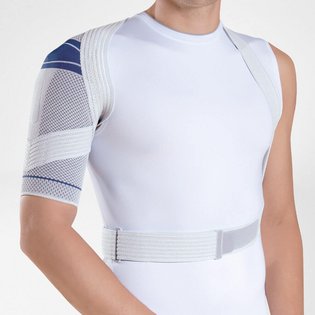Osteoarthritis of the shoulder can be the cause of pain and limited movement in the shoulder. When these types of symptoms occur, treatment is necessary. As part of the treatment, many conservative (non-surgical) measures are available because surgery to implant an artificial joint should always be the last resort. When osteoarthritis of the shoulder is treated early, the progression of the condition can be slowed down and pain alleviated.
Osteoarthritis of the shoulder: definition What is osteoarthritis of the shoulder joint?

The condition is known as osteoarthritis of the shoulder when the joint between the shoulder blade and the humeral head wears.
The results are an increasing loss of joint cartilage and wear of the joint surfaces. This, in turn, narrows the joint space more until the joint surfaces rub on each other. This friction causes great pain.
In general, osteoarthritis of the shoulder starts gradually, meaning those affected often don’t notice it during the early stages. If osteoarthritis of the shoulder remains untreated, pain and limited movement can increase. That’s why patients should be treated for osteoarthritis of the shoulder as soon as possible because joint-preserving therapy has the best chances of success when started early.
What causes osteoarthritis of the shoulder?
As is common with forms of osteoarthritis, the categorization of causes for osteoarthritis of the shoulder is divided into a primary and secondary type. In cases of primary osteoarthritis of the shoulder, a physician cannot detect the cause. Physicians assume that several factors come together. This includes mechanical and genetic conditions as well as occupations and hobbies where the arm is often raised to shoulder height. Maximum force is exerted on the shoulder joint in this position, in particular if weight is also being carried. In many cases, however, processes of wear in older age cause osteoarthritis of the shoulder.
If the osteoarthritis of the shoulder is the result of a disorder or injury, physicians refer to it as secondary osteoarthritis of the shoulder.
Possible causes for secondary osteoarthritis of the shoulder include:
- A cartilage disorder (chondromatosis)
- Joint inflammation
- Dislocated shoulder
- Anatomically related shoulder instability
- Upper arm fracture in the shoulder area
Symptoms of osteoarthritis of the shoulder: problems and progression of the condition

Primary osteoarthritis of the shoulder often goes undetected in its initial stages because those affected can still cope well with everyday activities, despite mild limitations in movement and pain. Pain when trying to get going in the morning and increasing problems with sideways and rotational movements of the arm are typical symptoms in the early stages of osteoarthritis of the shoulder.
When the condition progresses, the muscles atrophy, which patients notice as loss of strength in the arm. Stiffness of the shoulder joint is a subsequent result. Furthermore, all movements become painful, and sounds from the joints, such as “cracking” and “crunching”, can be heard. Eventually, pain will also occur at night and at rest.
Active patients usually notice osteoarthritis of the shoulder more quickly because pain and limited movement become obvious during exercise. This particularly affects sports where the shoulder plays a crucial role, such as tennis, handball, and volleyball. Performance continues to decrease because of the symptoms. The result is often a reduction in physical activity because the shoulder becomes stiff and pain worsens. To prevent decreased mobility, it’s therefore important to start treatment as quickly as possible.
Like all kinds of osteoarthritis, osteoarthritis of the shoulder cannot be reversed. With the right treatment, however, symptoms can be alleviated and the progression of the condition slowed down.
Osteoarthritis of the shoulder – diagnosis: Physicians provide certainty
As part of an examination that includes querying typical symptoms (case history), the physician will detect a more or less painful restriction in movement of the shoulder joint. To confirm the suspicion, an X-ray examination is useful. If narrowing of the joint space or even bony protrusions (osteophytes) on the humeral head are detected, the definitive diagnosis of osteoarthritis of the shoulder can be made.
Osteoarthritis of the shoulder – treatment: Which treatment measures are recommended?
Treating osteoarthritis of the shoulder initially follows conservative methods (without surgery), for example physiotherapy and anti-inflammatory pain medication.
If non-surgical treatment does not provide sufficient improvement, surgery must be considered. During an arthroscopy (key-hole surgery with minimal opening of the joint), the surgeon can smoothen the worn joint cartilage. Under some circumstances, this procedure is beneficial in an early stage to improve joint mobility. If osteoarthritis of the shoulder has progressed, the shoulder joint can be replaced by an artificial joint (endoprosthesis). This should be the last resort for alleviating severe chronic pain caused by osteoarthritis of the shoulder.
How do supports help in cases of osteoarthritis of the shoulder?
Supports stabilize and relieve the shoulder joint. The OmoTrain active support is a tried-and-tested product for shoulder problems in cases of osteoarthritis of the shoulder.
The humeral head is pulled back into a central position in the shoulder joint with a specialized strap system and the knitted fabric, thus providing relief. All movements become smoother and incorrect movements are prevented. Additionally, a special function pad (Delta pad) can be added and positioned as needed. The function pad, in conjunction with the knit of the support, creates a massage effect that stimulates circulation. This can alleviate pain, relieve tension, and promote mobility. The localized stimulation simultaneously activates the muscles. The shoulder joint is predominantly secured by muscles. This therefore provides additional stabilization which, in turn, can reduce pain and promote mobility.


